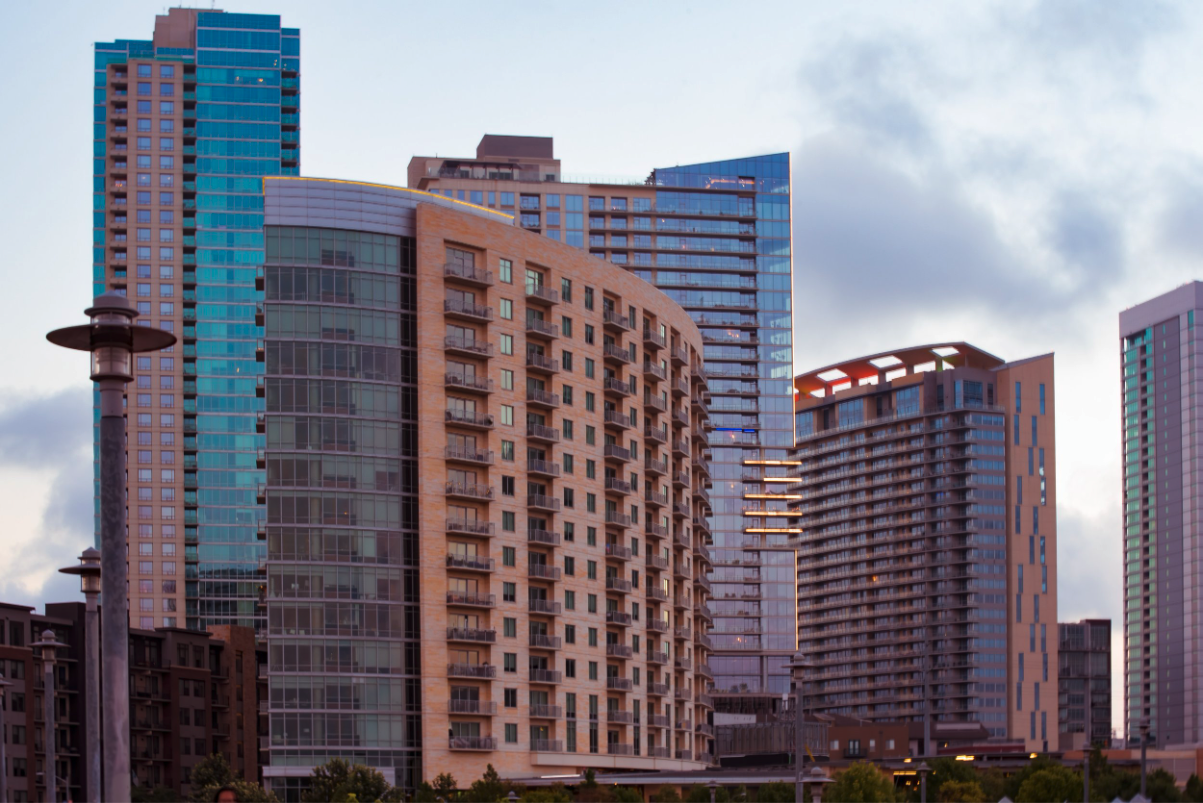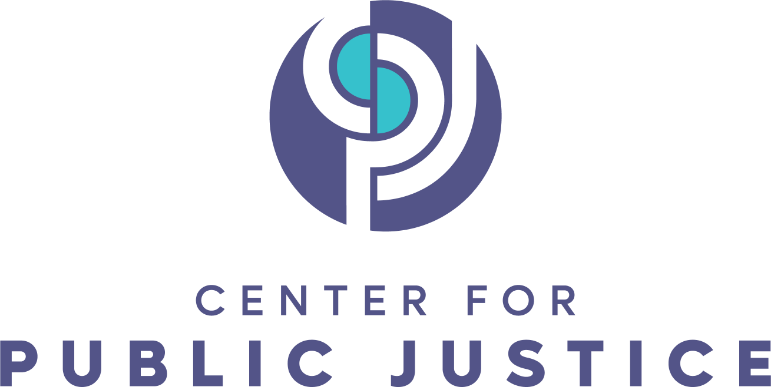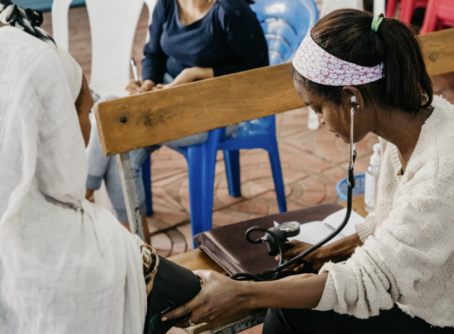
I typically try to avoid unnecessary eye contact while in public, but occasionally my eyes meet those of someone else despite my efforts. This time, the elderly man I had made eye contact with appeared further weathered and weary from having no home to provide him shelter from the Texas summer heat. He asked me how I was doing.
“Just fine. How about yourself?”
“Just waiting for them to come out,” he said, indicating the large wooden doors at the top of the steps. On that June Sunday morning, we were standing on the corner of 10th and Brazos in downtown Austin in front of Saint Mary Cathedral, a 19th-century Gothic church that, given its architectural style and beauty, looks like an out-of-place artifact, flanked on three sides by forgettable late 20th-century office buildings and a windowless TV studio on the other.
“Have you ever thought about joining them?” I asked, indicating the church.
A twinge of embarrassment passed through me immediately after hearing myself say this out loud. That was all I could think to say.
What I said has stuck with me, sounding too close to, “Well, why aren’t you in there?” Though my intention was to encourage him to seek help with his physical and spiritual needs within the church community, it certainly could have been said better. Embarrassment aside, I never learned how old he was, but he was certainly old enough to have seen Austin change from a mid-sized city with a rebellious hipster spirit into a capital for the technology industry, bursting at the seams with the young and ambitious.
Walking around downtown, in the shadows of the Independent and the Austonian — the two tallest residential skyscrapers west of the Mississippi — and among the Teslas and Porsches that lined the streets, I gawked in wonder at the how these incarnations of vast wealth could exist right beside evidence of great poverty. I watched as groups of homeless people sat unmoving under awnings and in alleys, sleeping or quietly speaking among themselves, while well-dressed couples and families debated where along Congress Avenue to get a nice Sunday brunch.
People may find themselves without a home for a wide variety of reasons, both individual and compounding. For many, losing the ability to afford housing is the fundamental problem. Almost certainly, the weathered man would have had a permanent roof over his head if he had the means to pay for it. But homelessness is at the bottom of a larger slippery slope of housing insecurity experienced by those who are unable to keep pace with the rise of housing costs. Before someone loses their home, he or she likely has experienced other financial difficulties such as the inability to pay for a dwelling large enough for a whole family or difficulty finding a job somewhere near a home they can afford.
No doubt, Austin’s exploding housing costs have done no favors for those facing housing insecurity. This spring, the city’s median home price hit $624,000, a 22 percent increase from 2021, while the median rent for a one-bedroom apartment reached $1,895 in July, a 28.25 percent increase from last year. Statewide, the median home price neared $360,000 in 2021, up from just under $200,000 nine years prior. This isn’t only a Texas problem. Cities nationwide that were once considered broadly affordable relative to coastal metropolises, including many in the American West, are struggling with soaring home values and rent prices, placing sometimes crippling economic strains on those unaccustomed to paying such high property taxes and monthly rents. For example, in fast-growing San Antonio, the Washington Post recently interviewed a woman from the historically black Dignowity Hill neighborhood whose property taxes increased from around $1,200 in 2010 to almost $5,000 this year.
How is affordable housing slipping so far out of reach so quickly for many individuals and families? One contributing factor can be found on the law books of almost every city in America. Among local codes that govern waste management and local taxes are municipal zoning codes that dictate what can be built and where, by assigning every piece of property within the local government’s jurisdiction to a particular zone type with a set of rules that apply to the lot. These rules typically include regulations on the minimum size of the lot, the height of any building on it, and the use of the land. Regulations such as these zoning codes raise housing prices and contribute to the lack of access to affordable housing many housing insecure and homeless people face.
There are nearly as many zoning codes as there are cities in America, but I will use Omaha Nebraska’s zoning code to provide a more concrete example of how they work. Omaha’s Code of Ordinances establishes the office of Planning Director and a planning board of seven members, all appointed by the mayor. The planning board writes up proposals and makes recommendations about city master planning and zoning policy to the city council, which then votes on whether to include them in the Code of Ordinances. Omaha’s zoning code categorizes the city into various districts: agricultural, residential, commercial, industrial, office and special districts; these districts then categorize the purpose for which lots can be used and have rules that dictate minimum lot sizes and maximum building heights, among others. Furthermore, the process to amend the zoning code text is tedious and difficult, since only the city government may initiate an amendment.
These zoning ordinances may seem perfunctory or arbitrary, but in reality they shape our neighborhoods and cities. By putting limits on minimum lot and maximum building sizes, zoning codes place caps on the housing supply, causing prices to rise. In many cities, zones that restrict development to detached, single-family homes govern most of the land, locking in the existing housing density. Furthermore, developers that purchase aging properties in high-demand areas are incentivized to optimize their return on investment by maximizing the size and value of the house built to replace the typically smaller home originally on the property, further reducing the supply of affordable housing. The results are increasingly visible in growing Sun Belt cities, like Austin, where new construction, responding to those with purchasing power seeking the largest home in the cheapest desirable location, tends to dwarf nearby homes. Exclusionary zoning, as it has come to be called, encourages economic segregation and limits affordable housing access to those who need it. It is important for Christian citizens to responsibly exercise their citizenship by becoming informed about and advocating for local policies that are good for their neighbors, including by advocating for affordable housing and inclusionary zoning policies.
INCLUSIONARY ZONING: A PUBLIC JUSTICE RESPONSE
Many of the arguments made against zoning reforms are based on concerns about changes in neighborhood character, reductions in property values, or fear that poorer neighbors will introduce disorder to an area. While the merits of opposing arguments should always be evaluated in particular debates, Christians must not let these concerns of wealth and comfort be first on our minds if we want to love our neighbors and communities. In the Bible’s most famous example of neighborly care, Jesus in Luke 10:25-37 tells the story of a man finding a beaten traveler on the side of the road. In contrast to the self-interest of the priest and Levite that pass by without rendering aid, the Samaritan — significantly, a man of a different cultural and ethnic background from Jesus’s Jewish audience — takes the traveler, binds his wounds, and at his own expense finds him shelter. Jesus ends with a command: “Go and do the same.”
“Go and do the same.
Public justice is the theory that the government and civil society serve to work in collaboration to seek complete human flourishing. The Center for Public Justice’s Guideline on welfare says “The call to be a ‘neighbor’ — to help those who are in need — is addressed to all people and all institutions.” This corresponds with Jesus’ call to help others in need regardless of ethnic background or ideology. A public justice response to the affordable housing crisis includes the government and nonprofits working together to promote more just and inclusive zoning regulations. Inclusionary zoning requires a certain percentage of new homes to be allotted as affordable units, creating a mixed-income community with access to the same, if not more, resources and amenities. Inclusive zoning allows higher access to affordable housing and education and integrates various socioeconomic classes, creating a more diverse community with the means to meet the needs of all residents. In turn, these policies will aid in getting homeless people off the street and into permanent housing. When the opportunity for zoning reform comes to our cities, whether through routine updates or citizen action, our position should not be defense of the status quo but a desire to make room for homes where lives may be built.
In response to the affordability crisis, interest in zoning reform has grown in recent years, leading to legislative changes in Oregon and Minneapolis that allow construction of duplexes and triplexes where only single-family homes were allowed before. Burgeoning reform movements are providing Christians with a critical opportunity to guide their communities to a more affordable future by loosening the regulations that prevent more homes, and styles of homes other than single-family houses, from being built in the parts of our cities that provide the greatest economic and social opportunity. Allowing more home construction would not only increase supply in areas with access to better jobs, schools, and civic organizations but also reduce the bidding wars being fought over neighborhoods that were not destinations for wealthier homebuyers until the more attractive neighborhoods filled up.
Still, changing zoning codes is no silver bullet but only a change in some of the rules that govern the housing economy in a city. Affordable homes still need to be created. Reforms may also be made to allow housing on the property of churches and other houses of worship so that they may provide shelter for people who have been evicted or displaced. Any solution to homelessness requires collaboration between the government and members of civil society, such as nonprofits, faith-based organizations, and churches, to provide resources for homeless and low-income people. Christian citizens like us are called to advocate for more inclusive policies and work with nonprofits to benefit homeless individuals and provide more affordable housing as a way to prevent poverty.
Ethan Floyd is a transportation engineer-in-training in South Texas.
WANT TO GET INVOLVED?
1. Sign up to receive Shared Justice’s monthly newsletter and stay up to date on the latest content, resources, and highlights.
2. Write for us! To learn more about writing for Shared Justice, email emily.fromke@cpjustice.org.
3. Form a Political Discipleship group to practice meaningful political engagement in your community. The Center for Public Justice’s Political Discipleship is a guide for active Christian citizenship, designed to empower people with skills and tools to shape policy and address inequality and injustice in their communities. To learn more about starting a group, visit our website or contact emily.fromke@cpjustice.org





